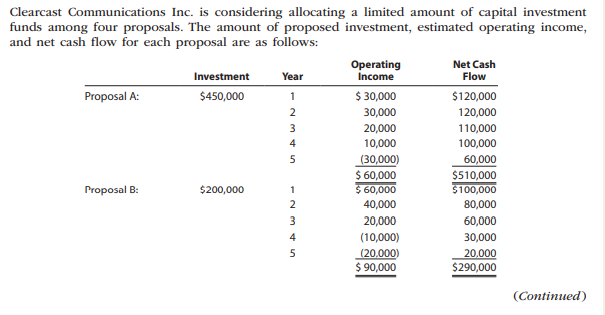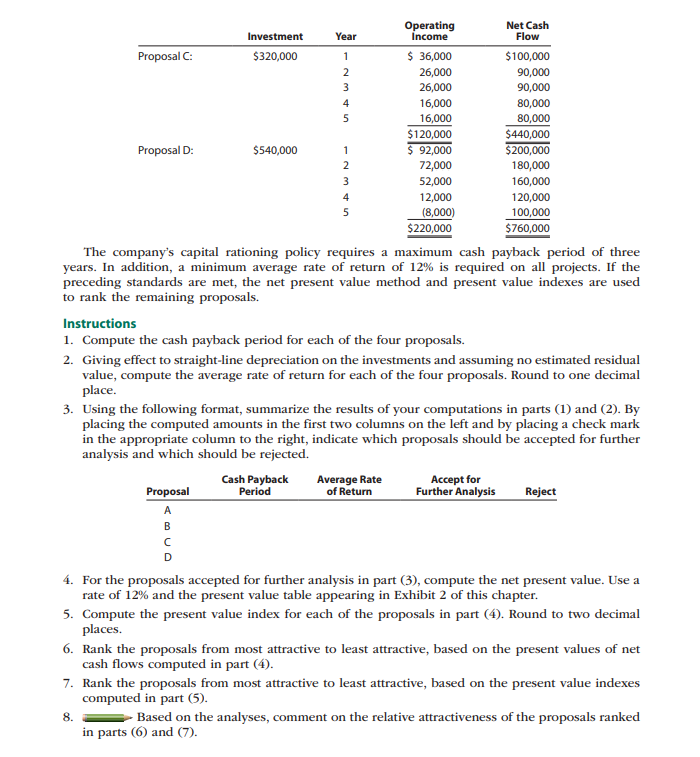Clearcast Communications Inc. is considering allocating a limited amount of capital investment funds among four proposals. The amount of proposed investment, estimated operating income, and net cash flow for each proposal are as follows: Operating Income Net Cash Flow Investment Year Proposal A: $450,000 $ 30,000 1 $120,000 2 30,000 120,000 3 20,000 110,000 4 10,000 100,000 (30,000) $ 60,000 $ 60,000 40,000 60,000 $510,000 $100,000 Proposal B: $200,000 1 80,000 3 20,000 60,000 4 (10,000) 30,000 (20.000) $ 90,000 20.000 $290,000 (Continued) Operating Income Net Cash Flow Investment Year Proposal C: $320,000 $ 36,000 $100,000 26,000 90,000 3 26,000 90,000 4 16,000 80,000 5 16,000 $120,000 $ 92,000 80,000 $440,000 $200,000 Proposal D: $540,000 1 2 72,000 180,000 3 52,000 160,000 4 12,000 120,000 5 (8,000) 100,000 $220,000 $760,000 The company's capital rationing policy requires a maximum cash payback period of three years. In addition, a minimum average rate of return of 12% is required on all projects. If the preceding standards are met, the net present value method and present value indexes are used to rank the remaining proposals. Instructions 1. Compute the cash payback period for each of the four proposals. 2. Giving effect to straight-line depreciation on the investments and assuming no estimated residual value, compute the average rate of return for each of the four proposals. Round to one decimal place. 3. Using the following format, summarize the results of your computations in parts (1) and (2). By placing the computed amounts in the first two columns on the left and by placing a check mark in the appropriate column to the right, indicate which proposals should be accepted for further analysis and which should be rejected. Proposal Cash Payback Period Average Rate of Return Accept for Further Analysis Reject A B D 4. For the proposals accepted for further analysis in part (3), compute the net present value. Use a rate of 12% and the present value table appearing in Exhibit 2 of this chapter. 5. Compute the present value index for each of the proposals in part (4). Round to two decimal places. 6. Rank the proposals from most attractive to least attractive, based on the present values of net cash flows computed in part (4). 7. Rank the proposals from most attractive to least attractive, based on the present value indexes computed in part (5). 8. Based on the analyses, comment on the relative attractiveness of the proposals ranked in parts (6) and (7).
Clearcast Communications Inc. is considering allocating a limited amount of capital investment funds among four proposals. The amount of proposed investment, estimated operating income, and net cash flow for each proposal are as follows: Operating Income Net Cash Flow Investment Year Proposal A: $450,000 $ 30,000 1 $120,000 2 30,000 120,000 3 20,000 110,000 4 10,000 100,000 (30,000) $ 60,000 $ 60,000 40,000 60,000 $510,000 $100,000 Proposal B: $200,000 1 80,000 3 20,000 60,000 4 (10,000) 30,000 (20.000) $ 90,000 20.000 $290,000 (Continued) Operating Income Net Cash Flow Investment Year Proposal C: $320,000 $ 36,000 $100,000 26,000 90,000 3 26,000 90,000 4 16,000 80,000 5 16,000 $120,000 $ 92,000 80,000 $440,000 $200,000 Proposal D: $540,000 1 2 72,000 180,000 3 52,000 160,000 4 12,000 120,000 5 (8,000) 100,000 $220,000 $760,000 The company's capital rationing policy requires a maximum cash payback period of three years. In addition, a minimum average rate of return of 12% is required on all projects. If the preceding standards are met, the net present value method and present value indexes are used to rank the remaining proposals. Instructions 1. Compute the cash payback period for each of the four proposals. 2. Giving effect to straight-line depreciation on the investments and assuming no estimated residual value, compute the average rate of return for each of the four proposals. Round to one decimal place. 3. Using the following format, summarize the results of your computations in parts (1) and (2). By placing the computed amounts in the first two columns on the left and by placing a check mark in the appropriate column to the right, indicate which proposals should be accepted for further analysis and which should be rejected. Proposal Cash Payback Period Average Rate of Return Accept for Further Analysis Reject A B D 4. For the proposals accepted for further analysis in part (3), compute the net present value. Use a rate of 12% and the present value table appearing in Exhibit 2 of this chapter. 5. Compute the present value index for each of the proposals in part (4). Round to two decimal places. 6. Rank the proposals from most attractive to least attractive, based on the present values of net cash flows computed in part (4). 7. Rank the proposals from most attractive to least attractive, based on the present value indexes computed in part (5). 8. Based on the analyses, comment on the relative attractiveness of the proposals ranked in parts (6) and (7).
Survey of Accounting (Accounting I)
8th Edition
ISBN:9781305961883
Author:Carl Warren
Publisher:Carl Warren
Chapter15: Capital Investment Analysis
Section: Chapter Questions
Problem 15.6.8P
Related questions
Question

Transcribed Image Text:Clearcast Communications Inc. is considering allocating a limited amount of capital investment
funds among four proposals. The amount of proposed investment, estimated operating income,
and net cash flow for each proposal are as follows:
Operating
Income
Net Cash
Flow
Investment
Year
Proposal A:
$450,000
$ 30,000
1
$120,000
2
30,000
120,000
3
20,000
110,000
4
10,000
100,000
(30,000)
$ 60,000
$ 60,000
40,000
60,000
$510,000
$100,000
Proposal B:
$200,000
1
80,000
3
20,000
60,000
4
(10,000)
30,000
(20.000)
$ 90,000
20.000
$290,000
(Continued)

Transcribed Image Text:Operating
Income
Net Cash
Flow
Investment
Year
Proposal C:
$320,000
$ 36,000
$100,000
26,000
90,000
3
26,000
90,000
4
16,000
80,000
5
16,000
$120,000
$ 92,000
80,000
$440,000
$200,000
Proposal D:
$540,000
1
2
72,000
180,000
3
52,000
160,000
4
12,000
120,000
5
(8,000)
100,000
$220,000
$760,000
The company's capital rationing policy requires a maximum cash payback period of three
years. In addition, a minimum average rate of return of 12% is required on all projects. If the
preceding standards are met, the net present value method and present value indexes are used
to rank the remaining proposals.
Instructions
1. Compute the cash payback period for each of the four proposals.
2. Giving effect to straight-line depreciation on the investments and assuming no estimated residual
value, compute the average rate of return for each of the four proposals. Round to one decimal
place.
3. Using the following format, summarize the results of your computations in parts (1) and (2). By
placing the computed amounts in the first two columns on the left and by placing a check mark
in the appropriate column to the right, indicate which proposals should be accepted for further
analysis and which should be rejected.
Proposal
Cash Payback
Period
Average Rate
of Return
Accept for
Further Analysis
Reject
A
B
D
4. For the proposals accepted for further analysis in part (3), compute the net present value. Use a
rate of 12% and the present value table appearing in Exhibit 2 of this chapter.
5. Compute the present value index for each of the proposals in part (4). Round to two decimal
places.
6. Rank the proposals from most attractive to least attractive, based on the present values of net
cash flows computed in part (4).
7. Rank the proposals from most attractive to least attractive, based on the present value indexes
computed in part (5).
8.
Based on the analyses, comment on the relative attractiveness of the proposals ranked
in parts (6) and (7).
Expert Solution
This question has been solved!
Explore an expertly crafted, step-by-step solution for a thorough understanding of key concepts.
This is a popular solution!
Trending now
This is a popular solution!
Step by step
Solved in 7 steps with 6 images

Follow-up Questions
Read through expert solutions to related follow-up questions below.
Follow-up Question
4. For the proposals accepted for further analysis in part (3), compute the
Solution
Knowledge Booster
Learn more about
Need a deep-dive on the concept behind this application? Look no further. Learn more about this topic, accounting and related others by exploring similar questions and additional content below.Recommended textbooks for you

Survey of Accounting (Accounting I)
Accounting
ISBN:
9781305961883
Author:
Carl Warren
Publisher:
Cengage Learning

Intermediate Financial Management (MindTap Course…
Finance
ISBN:
9781337395083
Author:
Eugene F. Brigham, Phillip R. Daves
Publisher:
Cengage Learning

Cornerstones of Cost Management (Cornerstones Ser…
Accounting
ISBN:
9781305970663
Author:
Don R. Hansen, Maryanne M. Mowen
Publisher:
Cengage Learning

Survey of Accounting (Accounting I)
Accounting
ISBN:
9781305961883
Author:
Carl Warren
Publisher:
Cengage Learning

Intermediate Financial Management (MindTap Course…
Finance
ISBN:
9781337395083
Author:
Eugene F. Brigham, Phillip R. Daves
Publisher:
Cengage Learning

Cornerstones of Cost Management (Cornerstones Ser…
Accounting
ISBN:
9781305970663
Author:
Don R. Hansen, Maryanne M. Mowen
Publisher:
Cengage Learning

Financial And Managerial Accounting
Accounting
ISBN:
9781337902663
Author:
WARREN, Carl S.
Publisher:
Cengage Learning,

Managerial Accounting
Accounting
ISBN:
9781337912020
Author:
Carl Warren, Ph.d. Cma William B. Tayler
Publisher:
South-Western College Pub

EBK CONTEMPORARY FINANCIAL MANAGEMENT
Finance
ISBN:
9781337514835
Author:
MOYER
Publisher:
CENGAGE LEARNING - CONSIGNMENT